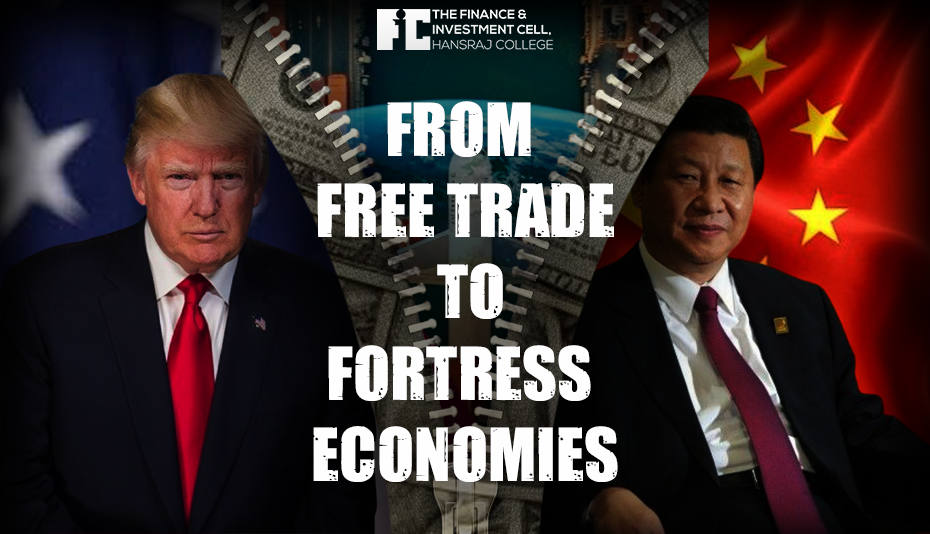From Free Trade to Fortress Economies
- fictechhrc
- Sep 28
- 4 min read
The Return of Tariff Power
The bedrock of modern global trade—the seamless movement of goods and capital across borders—is fracturing. For decades, the global economy prioritized efficiency above all else, but recent years have seen a powerful and persistent return to economic nationalism. This shift has elevated tariffs from an archaic trade barrier to a primary instrument of foreign policy.
A tariff war is not just a passing trade dispute, but a calculated campaign of retaliatory import taxes waged by major economies, including the United States, China, and the increasingly self-protective European Union. The goal is no longer simply to balance trade deficits, but to achieve geopolitical dominance and supply chain security for their own nation. This new reality forces every corporation and investor to acknowledge that the world is segmenting, and that political trust now outweighs immediate cost savings. The central tragedy is that these trade wars are sacrificing efficiency for security, leading to a permanent fracture in production and baking high costs into the system.

The Hidden Tax
The most immediate and pervasive consequence of a tariff campaign is a direct financial toll on the domestic economy, particularly through the mechanism of pricing. The political narrative that tariffs penalize foreign producers rarely survives economic scrutiny. The truth is that the cost of these import duties is overwhelmingly paid by businesses operating in the imposing country, who then pass it along to consumers.
This dynamic acts as a source of cost-push inflation. When a tax is levied on imported raw materials or intermediate parts, the final domestic price of the end product produced must rise to maintain profit margins. This mechanism turns trade friction into a higher cost of living for ordinary households. Goods that depend on intricate global supply lines, such as apparel and specialized electronics, see a significant and sustained increase in their domestic prices, creating a hidden tax on the consumer base.
Growth Paralysis
Beyond inflation, tariffs inject a paralyzing element of uncertainty into global commerce. The uncertainty caused by these policies puts heavy brakes on economic activity, visibly slowing worldwide growth. Corporate leaders, who require stability for long-term planning, become hesitant to commit to large-scale, multi-billion-dollar Foreign Direct Investment (FDI) projects. This investment paralysis chokes the flow of capital and contributes to a slowdown in economic activity across multiple regions. The engine of global commerce is sputtering. Total worldwide trade is visibly shrinking, a clear sign that the massive efficiency gains we once took for granted are being actively eroded.
Unraveling of Supply Chains
The long-term consequence of the tariff wars is the most dramatic: a move beyond temporary economic turbulence and into a realm of permanent industrial change. Companies have fundamentally shifted their philosophy. They are no longer searching for the cheapest source of production available globally, but are actively de-risking their entire operations by prioritizing supply chain resilience and geopolitical alignment.
The corporate mandate has transformed from the cost-obsessed 'Just-in-Time' delivery model to a 'Just-in-Case' preparedness ideology. The new reality requires firms to construct alternate, parallel supply chains, which is a massive undertaking requiring a vast expenditure of capital. This strategic migration has popularized two related corporate strategies: Near-shoring and Friend-shoring. Near-shoring is a geographical strategy, moving production closer to the end-consumer market (for e.g., from Asia to neighboring countries), thereby reducing logistical friction. Friend-shoring, conversely, is a purely geopolitical strategy, relocating production only to nations that are politically aligned and share mutual agreements.
Birth of New Economic Hubs
This strategic migration is actively remapping global production, creating entirely new centers of economic gravity. As companies move manufacturing away from politically sensitive areas, the old, established industrial powers are seeing their production shrink.
Meanwhile, emerging economies are becoming the surprising beneficiaries of this political fracturing. Regions like Southeast Asia, parts of Latin America, and Eastern Europe are experiencing a significant influx of new industrial investment. These nations offer the political stability or geographical proximity that global companies now desperately seek. This transfer of industrial capacity is a structural change that will not be reversed even if tariffs are eventually rolled back. The global manufacturing chessboard has been flipped, leading to a more complex future for international production.

A New World Order
The ongoing tariff wars confirm that the integration of the global economy has been supplanted by the priority of national security and economic sovereignty. The world is moving away from a system governed by neutral trade rules and toward one defined by strategic allegiance. We are witnessing the acceleration of a bifurcated trade system, where global markets are functionally splitting into distinct economic orbits, each anchored by a major power bloc. Trade continues, but it flows with the bias of political alliance. The rules-based system of international trade is being pushed aside as powerful nations prioritize their own agendas over global cooperation.
This leaves the global financial and investment community with an urgent realization: the return on investment must now incorporate a new layer of political risk. If this sustained period of economic nationalism is the new normal—if cost efficiency is permanently traded for geopolitical resilience—then the financial sector must adapt to a world where stability is fragmented. The most pressing question for the coming decade is: How must global investors and nations rewire their partnerships to stay stable and grow in a world that is now permanently split?
Author: Manya Singhal
Illustration: Dhruv Garg







Comments